
Sunday, October 30, 2005
Alex Nino's Kapre
Cool Alex Nino's splash panel for a nice story below. Story by Carlo J. Caparas. Published in the United Komiks #153, July 24, 1969.


Alex Nino's "Tales of Bruhilda"
Happy Halloween!


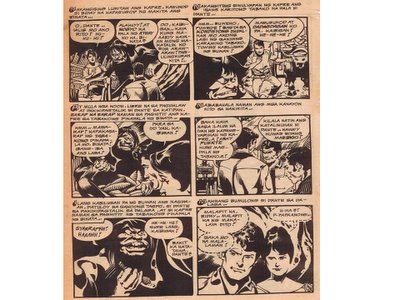
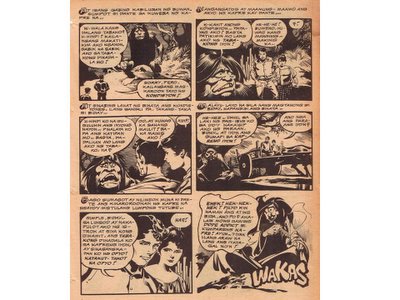
In Philippine lower mythology, the Kapre occupies a fascinating niche among the dark creatures of the night. The Kapre is invariably described as a gigantic man-like creature who had a passion for smoking tobacco. It is said to usually reside among tall and bushy trees just like the much dreaded Balite tree. According to old folks, the Kapre usually terrorizes bypassers at night, who happened to cross his tree while on the way to wakes, or going to haranas.
In the story below, Alex Nino illustrated his conception of how the Kapre looked like. This story was written by Carlo J. Caparas, and it was published in Pablo S. Gomez' United Komiks in late 1960s. This story is actually an episode of a very popular series in United Komiks called "Mga Kuwento ni Bruhilda"(Tales of Bruhilda Witch).
I loved the way Nino had drawn these "Bruhilda" stories. He was still a young artist then, and basically uninfluenced by foreign artists, so I could say that his drawing style then was raw and more natural. It was also a time when he had not gone deeper into experimentations. Yet, even then, Nino was already considered out of the mainstream style, dominated by Nestor Redondo and Francisco Coching. It was obvious that Nino was well ahead of his times, so that many local komiks editors failed to understand his genius. But then, two influential editors managed to give Nino his much needed break: Tony Velasquez of GASI and Pablo S. Gomez of PSG Publications. Of course it was Tony Velasquez who gave Nino his first illustrating job in GASI in 1966 with Velasquez' own stories "Mikrobyo", "Gamu-Gamo", and "Three Sisters". Nino's artworks for these stories were very accomplished .
Pablo S. Gomez also hitched his luck with Nino by giving him a regular illustrating job in the "Bruhilda" series. Both Velasquez and Gomez were full of praise for the magnificent artworks Nino had produced for them, a fact that irritated one komiks editor, with whom Nino had an earlier misunderstanding. From then on, Nino and Gomez would collaborate on sveral stories and novels, many of which even became highly succesful movies starring Filipino action star Fernando Poe, Jr.
So here then is one story from those popular "Bruhilda" stories from the 1960s. You will love to see how the hero of this story defeated the Kapre!
Enjoy the Halloween!




Thursday, October 27, 2005
Pokwang, Ang Maarteng Anak ni Aling Kikay
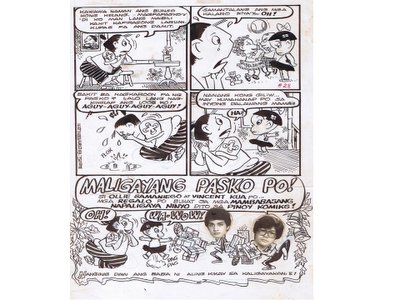
Vincent Kua's most famous komiks strip was Pokwang: Ang Maarteng Anak ni Aling Kikay. The author's hilarious byline was "Nagkakamot ng bukong-bukong na magdamag na binurire ni Vincent Kua, Jr."
In the 1980s and well into the 90s, Vincent proved to be one of the Philippines most popular writer/illustrator. He was a master of genres, particularly, period horror and historical romance. His drawing style was best loved by komiks readers because the characters he created were Venuses and Adonises: beautiful, handsome, cute, but not stone figures. They seemed to become movie stars in komiks, and people loved to see them grace the pages of their beloved komiks.
Yet people will always remember Vincent for his Pokwang strip, arguably the most popular cartoon strip of the 1980s. Its star, of course, is Pokwang, the diminutive smart-aleck girl whose wit and humor endeared her to komiks fans. Vincent admitted to me that one of his influences in the Pokwang strip was Tony Velasquez' Kenkoy, and indeed, Vincent took the four-mirrored windows on Pokwang's hair from that of Kenkoy.
The original art above was drawn for a Christmas 1983 issue of Pokwang. You could see a picture of Vincent there on the extreme right (with eyeglasses), together with his friend and frequent collaborator, writer Ollie Samaniego, giving their Christmas presents to Pokwang and Aling Kikay.
This is one of Vincent's souvenirs for me, which I will treasure for as long as I live.
Monday, October 24, 2005
Vincent Kua, Jr.
Last night, while browsing through Gerry Alanguilan's pictures of the Komikon in his website, I was wondering why Vincent Kua, Jr., was not able to attend the event, since three days ago, he himself told me he would attend the event. I was not available for the Komikon so I asked Vincent to just say hi to our old pals there.
Then, in a few moments, I received a text message from Randy Valiente, telling me that Vincent Kua had died on the previous night, apparently of stroke. I literally had goosebumps since one moment, I was thinking about Vincent, and then the next, learning that he had died.
Then, in a few moments, I received a text message from Randy Valiente, telling me that Vincent Kua had died on the previous night, apparently of stroke. I literally had goosebumps since one moment, I was thinking about Vincent, and then the next, learning that he had died.
Like many komiks fans, I had been a follower of Vincent's works in komiks during his heyday as writer/illustrator in the 70s and 80s. My sister and I would usually spend a portion of our school allowance, renting komiks that contained many of Vincent's wonderful stories. I specially loved his horror stories, as well as his regular Pokwang strips, while my sis usually anticipated his love stories.
When I became older, I sought out Vincent to know him personally. Through some komiks friends, I was able to get Vincent's phone number. I called him up and we had a nice conversation, and he even invited me in his home in Pasig. This was in 1997. From then on, we had a regular "kumustahan" and he frequently visited my apartment in Cubao, after getting his salary in Atlas, which was just a few minutes' walk away. We usually dine at Nena's, the oldest restaurant in the Cubao area, where Vincent loved the Puto Bumbong. One time, he went over to visit me and he brought along his friend, Randy Valiente. I found that Randy was himself a writer and a talented illustrator, and one of Vincent's close friends, although he looked so young.
One time, in my house, Vincent noticed that I had an stethoscope and a blood pressure monitor. I was then diagnosed with elevated blood pressure and had been regularly monitoring my BP. I asked him if he would like to check his BP, and he said: "Sige i-check mo magugulat ka" . His BP reading was, as I remember accurately, 180 over 110, which was very high for a normal person, so I asked him if he was feeling unwell. He smiled and said that he was fine, and that it was his normal BP, and that when it got lower than that he felt dizzy. He also mentioned that he always got a reading of 180 over 110 everytime he had his BP checked.
But then, being concerned about him, I told him to have a check-up. He said there was no need, it was just that there were people like him that had "normal" high BP reading.
I felt great regret of not having been able to convince him to go to the doctor then. I will miss him so much, his humor, his wisdom, his gentleness, and his humility. He is one of the truly great artists in our local komiks industry. I am very honored and priviledged that even for only a short period of time, I became his friend.
Sunday, October 23, 2005
KOMIKON 2005

This is me and Gerry Alanguilan at the recently held First Philippine komiks Convention or KOMIKON at the UP Bahay Alumni. That's the Humanis Rex poster we are holding, a sci-fi adventure comic strip by Gerry that is currently being serialized monthly in Fudge Magazine.
The Komikon was teeming with people of all ages, a proof that the old spirit of the Komiks is still very much alive in the Filipino consciousness. Of course, the dominant word you could hear there is the word "komiks". It's like a picnic, a get-together, a reunion. With all people of the same interest and hobby gathering and sharing their artworks, ideas, and lighthearted fun.
Gerry set up a vintage komiks exhibit, as well as a showcase of his original works, which I admire very much.
Alfredo Alcala's family also set up a mounted exhibit of the master's works, to the delight of the viewers. I myself, for a time, was glued at the works of the great Alfredo Alcala, and I am very pleased that his children, especially Fred and Christian, made great efforts of preserving his legacy.
Also, the Guhit Pinoy, a Filipino group of artists working in the Middle East, exhibited their recent artworks. Everyone admired their beautiful works, and I even heard some young artists say that old school is indeed better-looking than Manga.
For my booth, I decided to exhibit my collection of Telembang and Lipang Kalabaw comic-magazines, where the first Tagalog comic-strips appeared in the early 1920s. These magazines' comic strips were mostly illustrated by the great Fernando Amorsolo and Jorge Pineda, the two pioneer Filipino cartoonists.
A very funny man repeatedly visited my booth asking me what was the bookstore I bought my vintage magazines from, because he wanted to buy also those magazines, as if, one could still go to any bookstore and buy a Lipang Kalabaw or a Telembang just like you would do to an FHM! I'm not sure if he was joking, but he had this big smile in his face and was wearing a very funny-looking clown hat, so I joked to him to check out FILBARS' or ComicQuest, because possibly, they may carry back issues of the Lipang Kalabaw, and we burst out laughing afterwards. Since he was quite a pleasant person, I agreed that he take close-up shots (from his digital camera) of several covers of my magazines.
The Komikon is indeed, a good shot in the arm of a once fledgling komiks industry, but obviously a renaissance is in the making thru the efforts of such talented young artists like Gerry Alanguilan, Leinil Yu, Carlo Vergara, Randy Valiente, Jonas Diego, Arnold Arre, and a lot of other youngbloods in the field. With these people on the local komiks scene, it is indeed a great time to be a komiks fanatic once more, like most of our Nanays and Tatays' were in the 1950s to the 1970s.
I met a lot of old acquaintances there including artists Yong Montano, Jun Lofamia, and Coching's beauteous daughter, Maridel Coching, who in her own right is also an established artist.
The organizers said that, hopefully, the Komikon will be an annual event. If this is so, they can count again for my humble support in the following Komikon events.
I met a lot of old acquaintances there including artists Yong Montano, Jun Lofamia, and Coching's beauteous daughter, Maridel Coching, who in her own right is also an established artist.
The organizers said that, hopefully, the Komikon will be an annual event. If this is so, they can count again for my humble support in the following Komikon events.
Thursday, October 20, 2005
Guess the Artist

As a komiks collector, I know for a fact that comic art has a distinctive quality in it that firmly identifies its artist. Like painting, there are some specific things to be considered in identifying an art, the brush/pen strokes, cross-hatchings, a certain tilting of the figure, paneling, montage, shadowings, a certain look of the faces of the characters, etc. Hence, a person familiar with comic art of several artists can, with little effort, identify an art done by a particular artist even though in komiks art there have been some artists who imitated certain strong artists like Redondo or Coching.
For instance, one can easily differentiate a Coching with a Javinal art, even though to the unfamiliar, the two artworks may seem too much alike. Yet, there is still a great difference, and one must possess a keen eye on recognizing the tell-tale unioqueness of a Coching with a Javinal art.
As a regular feature of this blog, I will post, from time to time, a comic art, and let the viewers guess who its artist is. Since komiks artists only sign their names on the first page of the komiks originals, and the remaining 2-5 pages unsigned, it is highly important that a komiks collector identify properly an unsigned page.
The art featured above is one of my favorite pieces in my collection of original komiks art. My scanner, as with almost everyone else's, is too small to fit the entire page, so you get to see only a cropped version.
In this amazing page, the artist takes you right in the middle of a fierce battle scene, and you could almost hear the barbarians' yelling and the horses' hooves thumping. This is a splash page from one of my favorite komiks-novels in the early 1980s. Can you guess its artist?
The answer soon on my next post.
Tuesday, October 18, 2005
History in Cartoons
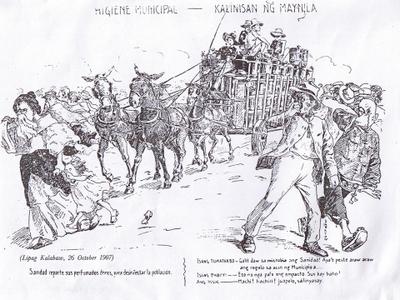
This is a satirical cartoon that appeared in the October 26, 1907 issue of the Lipang Kalabaw comic-magazine. Signed by La Ignation, a pseudonym used by artist Jorge Pineda, this cartoon provides a glimpse of history in the early years of the American Occupation.
Determined to transform Manila from a tawdry Asiatic port into a model metropolis, the Americans enforced strict sanitation regulations that angered Manilenos.
Back then, private toilets were only affordable by the rich, and the poor Manilenos had either to use public toilets or provide disposable cans for their usual call of nature.
While this cartoon shows public reaction to the noxious odors from the pail wagon that collected the "toilet cans", the chemical spraying of the streets and houses to prevent diseases was even more distasteful.
Such measures were absolutely necessary, however. The previous Spanish regime had not installed any systematic sewerage nor a potable water supply system, endangering Filipinos to the dangers of the outbreak of cholera, dysentery, and other water borne diseases. A fact that resulted in the death of one of our national heroes, Apolinario Mabini, who died during an outbreak of cholera in 1904.
At least, an effective sewerage system, and the later affordability of private toilets under the American occupation was one of the United States' enduring legacy in the Philippine Islands.
Friday, October 14, 2005
Mabuhay Komiks #8 1950

Here's another vintage Philippine komiks from the year 1950, Mabuhay Komiks, with an awesome cover art by illustrator Hugo Yonzon. Previously, in the earlier issues, it was Tony de Zuniga who illustrated the novel, with Yonzon taking over in issue number 7.
The cover features the novel "Ang Sawa sa Lumang Simboryo" by Amado Yasona, a komiks serial that was made into a movie of the same title in 1952. Directed by Manuel Vistan, this movie, in heavy competition with such film greats as "Korea", "Bagong Umaga" and "Basahang Ginto", ultimately bagged the very first FAMAS "Best Picture" and "Best Cinematography" awards in 1952.
Some of the stories included inside this komiks are the classics "Borong-Borong" horror serial by Teodoro Virrey, "Prinsipe Abante" by Deo Gonzales, and "Pamboy at Osang" by J.M. Perez. I had since then, made this cover my computer's wallpaper, explaining its stretched image.
Cool vintage stuff.
Thursday, October 13, 2005
Jorge Pineda, Pioneer Filipino Cartoonist
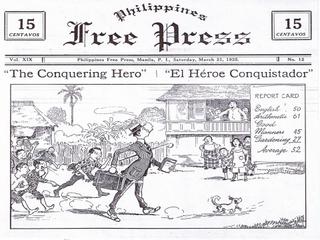
Together with Fernando Amorsolo, Jose Pereira, and Irineo Miranda, Jorge Pineda belonged to the first generation of Filipino cartoonists to have emerged during the early years of the American occupation.
These early Filipino cartoonists rarely sign their real names on the caricature box since most of their cartoon art were satirical in nature. Pineda was known to have used the psuedonyms Sirom and Makahiya.
In the cartoon shown above, from the Philippines Free press issue of March 21, 1925, Pineda depicted the Filipino provinciano student who was sent to Manila to study, and then on school vacation, returns to his native town like a conquering hero, with everyone admiring his fashionable clothes and the bearing of personality he had acquired in the city. Unbenknownst to his townmates, his report cards reveal that he was a truant student in the university, and a failure in his studies.
True as it was then as it is now.
Tuesday, October 11, 2005
A Dream of a Museum of Philippine Cartoons
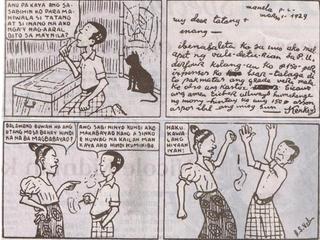
Here is another vintage Kenkoy strip from my archive of Philippine cartoons from a 1929 issue of the Liwayway.
One of my grandest plans in life is to build a museum of Philippine cartoons which would mainly showcase the works of the pioneer cartoonists of the Philippines like Jose Rizal, Fernando Amorsolo, Jorge Pineda, Jose Pereira, Irineo Miranda, Izzy Izon, Jose Zabala Santos and of course, the Father of Philippine Komiks, Tony Velasquez.
I got this idea when I met cartoonist Nonoy Marcelo-creator of Ikabod strip-five years ago, and he expressed to me his desire to have a museum of Philippine cartoons built, and was willing to discuss it to anyone who would care to listen. In fact, he showed me several papers relating to this future museum. It was sad he had not been able to realize his dream since he fell to an illness which led to his untimely death in 2002.
I felt great anguish upon learning of his death, since I'm one of those millions who admired and followed his Ikabod strips on a regular basis. Inspired by Mr. Marcelo, I began collecting Philippine komiks and original cartoon art. I spent quite a magnificent sum to gather my collection. Fortunately, I met several artists who were willing to sell me their old komiks and magazines, which brought me closer to realizing Mr. Marcelo's dream.
Last year, I even rented an expensive place in Quezon City to begin the museum. Sadly, lack of funds prevented my project from its full realization, and I had to close the place before the year was out. But I know I will still pursue this dream sooner or later. It will be done. And very soon.
Sunday, October 09, 2005
Kenkoy and President Roxas
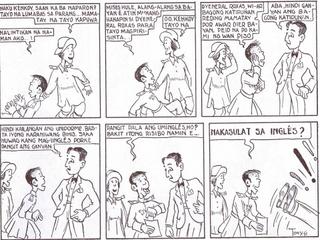
In 1931, a young politician named Manuel Roxas founded a society called the New Katipunan, which encouraged the Filipinos to turn their eyes back to their country instead of being too “Americanized”. Many people however, took note that Roxas addressed his New Katipuneros in English and wore woolen americana suit.
The malicious Kenkoy, eager to join the New Katipunan, donned himself in the uniform of a Katipunero(the likes worn by the Filipino army under General Aguinaldo), and paid for its one peso membership fee. In the comic strip, Kenkoy was able to meet Roxas in person, proudly telling him in his usual pidgin English that he was now a New Katipunero. Roxas told him that a katipunan uniform is not really necessary and that he should avoid talking in English “porke pangit ang ganyan”. Kenkoy, however had the last laugh when he asked Roxas, if English was so bad how come the receipt for the membership fee was itself written in English? Upon hearing this, Roxas had swooned and tripped backwards to emphasize the joke, leaving only his upturned legs shown while big exclamation marks hang in the air, in comic effect.
The malicious Kenkoy, eager to join the New Katipunan, donned himself in the uniform of a Katipunero(the likes worn by the Filipino army under General Aguinaldo), and paid for its one peso membership fee. In the comic strip, Kenkoy was able to meet Roxas in person, proudly telling him in his usual pidgin English that he was now a New Katipunero. Roxas told him that a katipunan uniform is not really necessary and that he should avoid talking in English “porke pangit ang ganyan”. Kenkoy, however had the last laugh when he asked Roxas, if English was so bad how come the receipt for the membership fee was itself written in English? Upon hearing this, Roxas had swooned and tripped backwards to emphasize the joke, leaving only his upturned legs shown while big exclamation marks hang in the air, in comic effect.
When Roxas became Philippine President in 1946 during the inauguration of the Third Philippine Republic, one of those invited to the banquet was Kenkoy creator Tony Velasquez. Indeed, the President was an admirer of Velasquez. As a gift, Velasquez gave the framed original art of this Kenkoy issue, and the President, who enjoyed the joke, kept it hung in his study in Malacanang.
Well, at least we know of one President who had appreciated an original comic art.
The World of Kenkoy
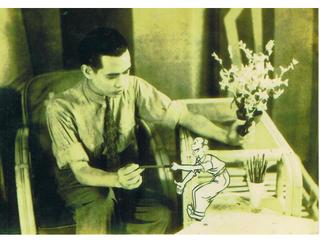
Arguably the most influential comic strip in the history of Philippine Komiks, Mga Kabalbalan ni Kenkoy was created in 1928 by eighteen-year old Tony Velasquez, in collaboration with Tagalog writer Romualdo Ramos. Kenkoy, the lead character of the strip was the first true pop-icon of the Philippines, and it was from his foibles and antics where an aging generation of Filipinos today received their first laughs from the komik strip.
Long before the advent of the movie stars, Kenkoy was the most popular figure during the pre-commonwealth years, his silhouette more recognizable compared to those of the leading politicians of the time such as then Senate President Manuel Quezon and Speaker Sergio Osmena.
The picture above is one of my favorite photographs of Tony Velasquez and his comic hero Kenkoy. Taken in 1932, this photo shows the mischievous Kenkoy attempting to snatch away the brush that created him. But Tony Velasquez seemed to have a good grip of his magical brush, and seemed to sternly lecture Kenkoy: "Don't you know that this brush is going to create a hundred more cartoon characters just like you are?"
Indeed, at the time of Velasquez' retirement in 1972, he had already created some 300 comic characters, many of which became very familiar with the Filipinos: Talakitok, Talimusak, Ponyang Halobaybay, Chiribiribin, Tsikiting Gubat, Binong, Captain Cortal, Tirso, Nanong Pandak, Aling Hule, Tikboy, Nars Cafi, Tonyo, Bobot the Robot, Mang Teroy, Ak, Awk, Ngak, Isko, Rosing, Aling Matsay, Don Koludio, Doktor Wakwak, Tinyente Dikyam, Donya Karay, Dyuli, Etot, Balugay, Mantica, Itsay, Edong, Saring Bulilit, Totong Barungkol, Ditektib Bembo, Tio Tasyo, Dalisyosa, Kenkoy Dayunyor......Hmmm...would blogger have enough word space for me to list everyone? Well, stay tuned because every Velasquez comic creation would have a limelight in this blog.
Friday, October 07, 2005
Photo-Komiks

In the early 1970s, a little after Tony Velasquez' retirement as GASI general manager, GASI experimented with a new type of komiks which would remove illustrators from komiks production: the Photo-Komiks.
Actually, even before Velasquez' retirement, he was already being pressured to launch the Photokomiks, but Velasquez relentlessly refused, since he knew that it would be unfair to illustrators, who, after all, contributed greatly to the success of the komiks industry.
At this time, komiks pages had already been dominated with showbiz gossips and pictures of movie stars, and the new GASI management thought it was a brilliant idea to put movie stars in the komiks panels as well. As it turned out, the Photokomiks was a brilliant flop, and the komiks industry, already in a bad shape, plunged deeper into its lowest depths ever.
The regular komiks readers shunned the Photokomiks, and the komikbooks which featured it-Kislap and Teens Weekly-went virtually unsold on the newsstands. After only a few issues, the Photokomiks was immediately discontinued.
Nothwithstanding Teny Henson's nice photography, I think Filipinos were not yet ready to replace their favorite illustrators with photographs.
I still believe Filipinos would not trade a Coching or Redondo art with a picture of their favorite movie stars. At least that's what quickly comes to the mind of a komiks art fanatic. Like me...
Wednesday, October 05, 2005
Orig Art Advertisement for Esco Shoes 1932

Not many people know that aside from being the Father of Philippine Komiks, Tony Velasquez was also the Father of Philippine Cartoon advertising. Originally, in1927, 17-year old Velasquez was employed by Banaag Press, to design labels for commercial products. Then in 1928, Banaag Press was purchased by the Roces Publications owned by Don Ramon Roces. It was in the same year when Velasquez created Francisco Harabas, a.k.a., Kenkoy, in the pages of the Liwayway.
While churning out his weekly Kenkoy cartoons in the Liwayway, Velasquez was also creating cartoon advertisements, the first of its kind in the Philippines. Some of the characters he created for these products were Captain Cortal for Cortal, Nars Cafi for Cafiaspirina, Tikboy for Tikitiki, and Isko for Esco shoes.
Although I have collected many of Velasquez original art for Kenkoy, I have very few of his original cartoon advertisements. One of the extant ones is an original ad for Esco shoes which appeared in the December 30, 1932 issue of the Liwayway.
As you can see, the art is already in a sorry state, with creases and needle holes affecting it throughout. To protect it from further damage, I had encased it in a thick mylar plastic which I bought bulk in Chinatown.
This original ad provides a fascinating look at what it was to visit Manila during the early 1930's and indeed, it reflected the general concern of people at the time, regarding the danger of car accidents happening in the streets.
At that time, the narrow streets of Manila had not yet adapted to the increasing numbers of cars and, as such, numerous accidents were prone to happen.
As you can see, Isko managed to topple one of the cars that accidentally hit him, and that's because he was wearing the "old reliable" Esco shoes. Of course it was absurd, but Filipinos loved this advertisement just the same.
Oh well, a piece of art can really be related to a piece of history.
Tuesday, October 04, 2005
Silangan Komiks #5 1950
 Somebody offered me this old specimen of Silangan Komiks for 2000 pesos. Even as a hardline vintage komiks collector, I admit it is a little way beyond my budget. But this is a 1950 komikbook with a marvelous Coching cover, so how can I pass? After a little haggling on the price, I finally got it for 1750 pesos. I am very happy.
Somebody offered me this old specimen of Silangan Komiks for 2000 pesos. Even as a hardline vintage komiks collector, I admit it is a little way beyond my budget. But this is a 1950 komikbook with a marvelous Coching cover, so how can I pass? After a little haggling on the price, I finally got it for 1750 pesos. I am very happy.I could keep the 250 pesos I saved or with a little extra money, finally buy the paperback edition of Da Vinci Code my friends insisted me to buy. Hhmm.
1750 pesos for a Coching and 250 for a Da Vinci.
Not too bad.
Si Prayle Botiok
Noong ang Pilipinas ay nasa ilalim pa ng pamamahala ng mga Kastila ay mayroong isang prayleng dominikano ang lubos na naging mayaman dahilan na rin sa matalinong pangangamkam ng mga lupain ng mga inosenteng indio. Tumaba ng husto ang prayleng ito at gayon na lamang ang inilaki ng kanyang tiyan kaya't siya'y palihim na tinutukso ng mga indiyo na "Prayle Botiok" gayung ang tunay na pangalan niya ay Gaspar. Lumipas ang mga ilang panahon ay nabahala na si Prayle Botiok sa patuloy na paglaki ng kanyang tiyan, at tuloy ay nagpanukala na kumunsulta sa mga dalubhasang duktor sa Maynila.
Kaya't isang araw ay sakay ng magarang karwahe at nagtuloy sa isang bahay pagamutan sa Maynila, na nagkataong ang pinunong duktor ay isang indio na nakapagtapos ng medisina.
"Ano po ba ang inyong dinaramdam, mahal kong padre" ani ng duktor na tunay na namangha sa labis na pintog ng tiyan ng prayle.
"Nais ko po sanan ipasuri an akin na tiyan at lubos yatang lumalaki at ako tuloy ay nahihirapang gampanan an akin mana tungkuling pangsimbahan"
"Ang mabuti po ay matistis natin upang malaman kung ano ang nasa loob niyang inyong tiyan"
"Kung siya pong makabubuti" ang sagot ng prayle.
Kaya't ipinasya na sa lalong madaling panahon ay kailangang operahin ang tiyan ng naturang prayle. Ang pagtitistis ay itinakda ng gabi ring iyon.
Kinagabihan ay handa na ang lahat at ang prayle ay ipinasok na sa silid-tistisan, at agad na pinatulog upang di maramdaman ang sakit ng pagbibiyak ng tiyan.
Samantala, habang ang prayle ay mahimbing na natutulog ay nangagtawanan ang mga duktor na gagawa ng pagtitistis at sinabing kapag nagising ang prayle ay sabihing isang sanggol na lalaki ang nakuha sa loob ng kanyang bundat na tiyan.
"Hahaha" ang sabi ng isang duktor "Subali't paano kung hanapin niya ang sanggol, ay saan baga tayo kukuha?"
"Mahina ka pala", ang sagot ng isa pang duktor "Hindi bat may isang sanggol na isinilang kanina at namatay ang ina, at walang ibang kamag-anak? Ang sanggol na iyan ang sasabihin nating nakuha sa loob ng kaniyang tiyan"
At sabay na nagtawanan ang dalawang duktor.
Kinabukasan, and prayle ay unti-unting nagmulat ng kaniyang mga mata, at ang unang sinipat ay ang kaniyang tiyan. Nakita niyang ito ay higit na maliit kaysa dati kaya't nahinuha na ang operasyon ay matagumpay na naidaos.
Totoong mahinang mahina pa ang prayle subalit ang una niyang nais malaman ay kung ano ang nakuha ng mga duktor sa kaniyang tiyan.
"Mahal na Prayle", ani ng duktor "ang inyo pong tiyan ay naglalaman ng sanggol na lalaki".
Halos mawalan muli ng ulirat ang prayle pagkaraang marinig ito, ikinusot ang mga mata at baka naman siya'y nananaginip lamang. Subalit sa darating ang isa pang duktor at dala dala ang sanggol na lalaki.
"Diyata't!?", ang pabulalas ng prayle, "Santisima!Napakalaking milagro nito at di ko akalain na ito'y maaaring maging totoo!"
Kaya't umuwi na nga ang prayle at napaniwalang tunay nga niyang anak ang sanggol na lalaki.
Mabilis na lumipas ang panahon, at ang sanggol na lalaki ay naging isang musmos, at pagkalipas pa ng ilang panahon ay naging bagong tao, at nagbinata.
Ang prayle ay totoong matanda na at naghihingalo na at malapit ng mamatay, kaya't sa huling sandali'y kinausap niya ang anak at sinabing ipinamamana niya ang lahat niyang lupain sa kanya.
"Subalit", ang malungkot na wika ng prayle "mayroon lamang akong isang bagay na ipagtatapat sa iyo. At sana'y huwag mong ikagagalit"
"Ano po iyon aking ama" ang sagot naman ng binata.
"Ako hindi ang iyon tunay na ama" ang naluluhang sagot ng prayle sa nagugulumihanang binata. "Nguni't kayo po ang kinilala kong ama sapul ng ako'y bata pa" ang tugon naman ng binata
"Ang totoo'y hindi mo talaga ako ama" ang sagot ng nag-aagaw buhay ng prayle, "ang iyong ama......... ay ang.......................sakristan..." at saka na lamang nalagutan ng hininga si Prayle Botiok.
Kaya't isang araw ay sakay ng magarang karwahe at nagtuloy sa isang bahay pagamutan sa Maynila, na nagkataong ang pinunong duktor ay isang indio na nakapagtapos ng medisina.
"Ano po ba ang inyong dinaramdam, mahal kong padre" ani ng duktor na tunay na namangha sa labis na pintog ng tiyan ng prayle.
"Nais ko po sanan ipasuri an akin na tiyan at lubos yatang lumalaki at ako tuloy ay nahihirapang gampanan an akin mana tungkuling pangsimbahan"
"Ang mabuti po ay matistis natin upang malaman kung ano ang nasa loob niyang inyong tiyan"
"Kung siya pong makabubuti" ang sagot ng prayle.
Kaya't ipinasya na sa lalong madaling panahon ay kailangang operahin ang tiyan ng naturang prayle. Ang pagtitistis ay itinakda ng gabi ring iyon.
Kinagabihan ay handa na ang lahat at ang prayle ay ipinasok na sa silid-tistisan, at agad na pinatulog upang di maramdaman ang sakit ng pagbibiyak ng tiyan.
Samantala, habang ang prayle ay mahimbing na natutulog ay nangagtawanan ang mga duktor na gagawa ng pagtitistis at sinabing kapag nagising ang prayle ay sabihing isang sanggol na lalaki ang nakuha sa loob ng kanyang bundat na tiyan.
"Hahaha" ang sabi ng isang duktor "Subali't paano kung hanapin niya ang sanggol, ay saan baga tayo kukuha?"
"Mahina ka pala", ang sagot ng isa pang duktor "Hindi bat may isang sanggol na isinilang kanina at namatay ang ina, at walang ibang kamag-anak? Ang sanggol na iyan ang sasabihin nating nakuha sa loob ng kaniyang tiyan"
At sabay na nagtawanan ang dalawang duktor.
Kinabukasan, and prayle ay unti-unting nagmulat ng kaniyang mga mata, at ang unang sinipat ay ang kaniyang tiyan. Nakita niyang ito ay higit na maliit kaysa dati kaya't nahinuha na ang operasyon ay matagumpay na naidaos.
Totoong mahinang mahina pa ang prayle subalit ang una niyang nais malaman ay kung ano ang nakuha ng mga duktor sa kaniyang tiyan.
"Mahal na Prayle", ani ng duktor "ang inyo pong tiyan ay naglalaman ng sanggol na lalaki".
Halos mawalan muli ng ulirat ang prayle pagkaraang marinig ito, ikinusot ang mga mata at baka naman siya'y nananaginip lamang. Subalit sa darating ang isa pang duktor at dala dala ang sanggol na lalaki.
"Diyata't!?", ang pabulalas ng prayle, "Santisima!Napakalaking milagro nito at di ko akalain na ito'y maaaring maging totoo!"
Kaya't umuwi na nga ang prayle at napaniwalang tunay nga niyang anak ang sanggol na lalaki.
Mabilis na lumipas ang panahon, at ang sanggol na lalaki ay naging isang musmos, at pagkalipas pa ng ilang panahon ay naging bagong tao, at nagbinata.
Ang prayle ay totoong matanda na at naghihingalo na at malapit ng mamatay, kaya't sa huling sandali'y kinausap niya ang anak at sinabing ipinamamana niya ang lahat niyang lupain sa kanya.
"Subalit", ang malungkot na wika ng prayle "mayroon lamang akong isang bagay na ipagtatapat sa iyo. At sana'y huwag mong ikagagalit"
"Ano po iyon aking ama" ang sagot naman ng binata.
"Ako hindi ang iyon tunay na ama" ang naluluhang sagot ng prayle sa nagugulumihanang binata. "Nguni't kayo po ang kinilala kong ama sapul ng ako'y bata pa" ang tugon naman ng binata
"Ang totoo'y hindi mo talaga ako ama" ang sagot ng nag-aagaw buhay ng prayle, "ang iyong ama......... ay ang.......................sakristan..." at saka na lamang nalagutan ng hininga si Prayle Botiok.
Subscribe to:
Posts (Atom)
